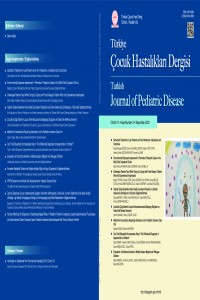Yatarak Tedavi Gerektiren Akut İshalli Çocukların Rotavirüs ve Enterik Adenovirüs Enfeksiyonu Yönünden Değerlendirilmesi
Öz
Giriş: Çocuklarda görülen
akut ishallerde en sık viral etkenler rotavirüs ve enterik adenovirüstür. Her iki etkenin neden olduğu
ishallerde çocukların klinik tablosu çok hızlı
kötüleşebilmektedir. Kusma, dehidratasyon ve metabolik asidoz sonucu,
hastalarda yatarak tedavi endikasyonu
ortaya çıkmaktadır. Çalışmamızda yatarak tedavi gören enterik adenovirüs ve
rotavirüs ishalli vakaları epidemiyolojik açıdan değerlendirerek demografik
verilerini irdelemek ve hangi tedavilerin uygulandığını göstermeyi amaçladık.
Gereç ve Yöntemler: İstanbul Yeni Yüzyıl
Üniversitesi Tıp Fakültesi Gaziosmanpaşa Hastanesi'ne 1 Ocak 2016-31 Aralık 2017
tarihleri arasında ishal şikayeti ile başvuran 0-14 yaş aralığında 1281
çocuk hasta retrospektif olarak incelendi. Bu hastalar arasında akut
gastroenterit tanılı, rotavirüs ve enterik adenovirüs antijen testi
değerlendirilmiş, gaita mikroskopisinde parazit olmayan ve gaita kültüründe Salmonella-Shigella
spp üremesi olmayan ve hastanede en
az 24 saat yatış süresi olan 443 hasta çalışma grubu olarak belirlendi. İstatistik metodu olarak T testi ve Ki kare testleri kullanıldı.
Çalışmada p<0,05 değeri anlamlı olarak kabul edildi.
Bulgular: İshal şikayeti ile
başvuran 1281 hastanın 443(%34,6)’ü yatarak takip edildi. 38 (%2,9) hastada
enterik adenovirüs, 95(%7,4) hastada ise
rotavirüs antijeni testi pozitif idi. Hastalarda
ki en sık şikayetler sıklık sırasıyla bulantı-kusma, halsizlik ve ateş olup,
karın ağrısı en az saptanan şikayettir. Yatarak tedavi edilen hastalarda tek başına probiyotik
kullanımı rotavirüs ishalli hastalarda %61, enterik adenovirüs enfeksiyonlu
hastalarda %63,2 oranında en sık
kullanılan ilaç grubu olmuştur.
Antibakteriyel etkili antibiyotikler %58 oranında rotavirüs ve enterik
adenovirüs antijeni negatif ishalli hastalarda, en yüksek oranda
kullanılantedavi ajanıdır. Antiprotozoal etkili antibiyotikler, rotavirüs antijeni
ve enterik adenovirüs antijeni pozitif grupta ve her iki etken için negatif
hasta grubunda en az tercih edilen ilaçlardı.
Tartışma: Çocukluk çağı
ishallerinde viral etkenler göz önünde bulundurulmalıdır. İshalin tedavisinde
öncelikle kaybedilen sıvının yerine konması planlanmalıdır. Antibakteriyel ya
da antiprotozoal antibiyoterapi için laboratuvar testleri yönlendirici
olmalıdır. Hastanede yatarak tedavi gören ve viral etyoloji düşünülen ishalli
çocuk hastalara rotavirüs ve enterik adenovirüs antijeni hızlı tanı testleri
kullanılarak erken tanı konulabilieceği, böylece semptomatik tedaviler ile gereksiz antibiyotik kullanımın önüne
geçilebileceği değerlendirilmiştir.
Anahtar Kelimeler
Kaynakça
- Referans 1. Smok B, Zieniewicz-Cieślik K,Smukalska E, Pawłowska M. Acute diarrhoea induced by rotavirus in children hospitalysed in Provincial Hospital for Infectious Diseases in Bydgoszcz in 2014 year. Przegl Epidemiol 2016;70(3):462-470. Referans 2. Kurugöl Z. Devrim İ. Gastrointestinal Infections. J Pediatr Inf 2014;8:71-81.Referans 3. Farkas T, Jiang X. Rotaviruses, caliciviruses, astroviruses, enteric adenoviruses and other diarrheic viruses. In: Murray PR, Baron EJ, Jorgensen JH, Landry ML, Pfaller MA eds. Manual of Clinical Microbiology. 9th ed. Washington: ASM Press, 2007 Referans 4. Bass CW, Dorsey KN: Rotavirus and other agents of viral gastroenteritis. In Nelson Textbook of Pediatrics Edited by: Richard E and Behrman F. Raven Press, Philadelphia, 2004Referans 5. Crawford SE, Ramani S, Tate JE, Parashar UD, Svensson L, Hagbom M, Franco MA, Greenberg HB, O’Ryan M, Kang G, Desselberger U, Mary Kestes. Rotavirus infection. Nat Rev Dis 2018;9:3.Referans 6. Ozdemir S, Delialioğlu N, Emekdaş G. Investigation of rotavirus, adenovirus and astrovirus frequencies in children with acute gastroenteritis and evaluation of epidemiological features. Mikrobiyol Bul 2010; 44: 571-8.Referans 7. Junaid SA, Umeh C, Olabode AO, Banda JM: Incidence of rotavirus infection in children with gastroenteritis attending Jos university teaching hospital. Nigeria. Virol J 2011;8:233. Referans 8. Salim H, Karyana IPG, Sanjaya-Putra1 IGN, Budiarsa S and Soenarto Y. Risk factors of rotavirus diarrhea in hospitalized children in Sanglah Hospital, Denpasar: a prospective cohort study. BMC Gastroenterology 2014;14:54.Referans 9. Gürbüz F, Tezer H, Şaylı TR. Etiologic factors and Clinical findings of patients hospitalized chidren for acut gastroenteritis epidemiologic study. Turkish J Pediatr Dis 2010;4(4):211-218.Referans 10. Ozdemir S, Delialioğlu N, Emekdaş G. Investigation of rotavirus, adenovirus and astrovirus frequencies in children with acute gastroenteritis and evaluation of epidemiological features. Mikrobiyol Bul 2010;44:571-8. Referans 11. Altındiş M, Beştepe G, Çeri A ve ark. Akut ishal yakınmalı çocuklarda rotavirüs ve enterik adenovirüs sıklığı araştırma. S.D.Ü. Tıp Fak. Derg 2008:15(2):17-20.Referans 12. Wiegering V, Kaiser J, Tappe D, Weissbrich B, Morbach H, Girschick HJ. Gastroenteritis in childhood a retrospective study of 650 hospitalized. Int J Infect Dis. 2011;15(6):e401-7. Referans 13. Jaha VI, Shala M, Azemi M, Hoxa-Kanberi T, Avdiu M, Spahiu S, Jaha L. Characteristics of Rotavirus Diarrhea in Hospitalized Children in Kosovo Materia Socio Medica 2014;26(5):335–338.Referans 14. Parashar UD, Nelson EAS, Kang G. Diagnosis, management, and prevention of rotavirus gastroenteritis in children BMJ 2013;30;347: f7204. Referans 15. Multicenter Prospective Study of the Burden of Rotavirus Acute Gastroenteritis in Europe 2004 – 2005: The Reveal Study. J Infect Dis 2007;195(1):S4–S16.Referans 16. Nakanishia K, Tsugawab T, Honmaa S, Nakata S, Tatsumi M, Yoto Y, Tsutsumi H. Detection of enteric viruses in rectal swabs from children with acute gastroenteritis attending the pediatric outpatient clinics in Sapporo. Japan J Clin Virology 2009;46:94- 7. Referans 17. Nitsch-Osuch A, Kuchar E, Kosmala A, Życinska1 K, Wardyn1 K. Nosocomial rotavirus gastroenterocolitis in a large tertiary pediatric hospital in Warsaw, 2006-2010. Arch Med Sci 2013;9(3):493-8. Referans 18. İnan N, Ünsur E.K, Demirel A ve ark. Akut viral gastroenterit öntanılı vakalarda rotavirus, adenovirus ve norovirus sıklığının araştırılması. Ankem Derg 2014;28(1):14-9. Referans 19. Guarino A, Albano F, Ashkenazi S, et al. European Society for Paediatric Gastroenterology, Hepatology, and Nutrition/European Society for Paediatric Infectious Diseases evidencebased guidelines for the management of acute gastroenteritis in children in Europe: executive summary. J Pediatr Gastroenterol Nutr 2008;46:619-21.
Ayrıntılar
| Birincil Dil | Türkçe |
|---|---|
| Konular | İç Hastalıkları |
| Bölüm | ORIGINAL ARTICLES |
| Yazarlar | |
| Yayımlanma Tarihi | 29 Mayıs 2020 |
| Gönderilme Tarihi | 7 Ocak 2019 |
| Yayımlandığı Sayı | Yıl 2020 Cilt: 14 Sayı: 3 |


